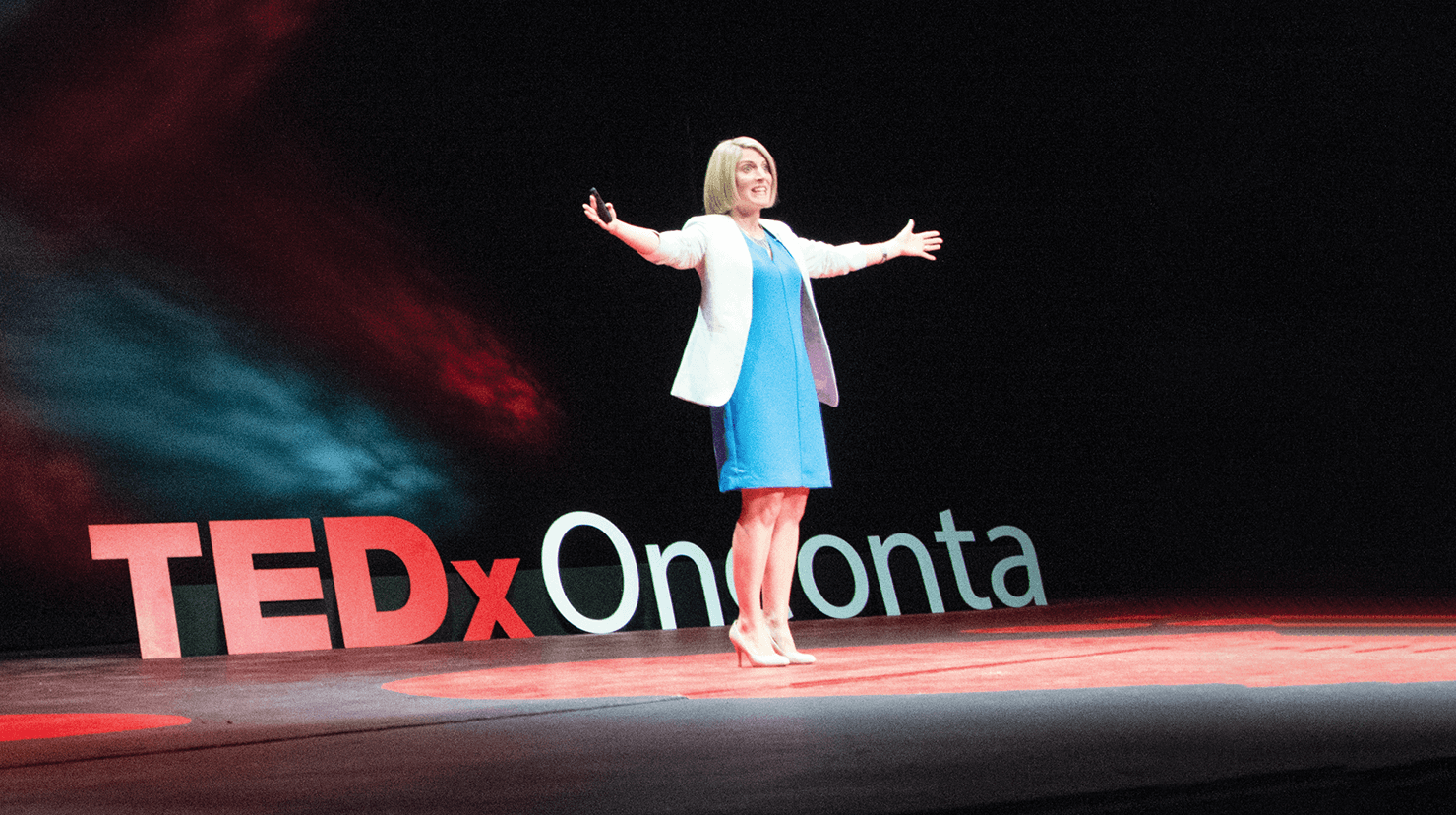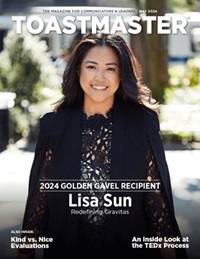If you daydream of giving a TEDx Talk on the big red dot, you’re in good company. And what guides that reverie into reality is often unraveling the unknowns—the application, audition, and presentation, and perhaps more so the pivotal query: Is my idea truly worth spreading?
While TED Talks are large-scale events focused on bringing together well-known speakers, a TEDx Talk is organized at a local level, and volunteers search for unique ideas from lesser-known voices. Often, TEDx teams select a theme for speakers to focus on. The benefit is speakers can interpret the theme in their own way, allowing for a diversity of topics. The goal of TEDx is to spark conversation, connection, and community.
As a speaker coach for the TEDxRRU team in Victoria, British Columbia, Canada, I have spoken directly with speakers and event curators to dispel the unknowns. I want to share how the TEDx process works, and unveil what curators are looking for in presentation ideas. Get ready, because implementing these tips may make your TEDx dream a reality.
1 Brainstorming
“Ideas worth spreading.” This event tagline may be the most important piece of advice. Before filling out the application, the actual first step is to clearly understand your idea, and decide whether that idea is, as the slogan suggests, worth spreading. If your idea is new, factual, and interesting to a broad audience, you’re on track.
Relatable topics are a bonus, but even complex topics like artificial intelligence can be made relatable. Just ask Peter Scott, DTM, author and instructor, who presented at the 2023 TEDxRRU conference in Canada, on this very topic.
“TEDx is about communicating something that your audience is going to find worth their time,” says Scott, who has spoken on a TEDx stage four times, been a content curator (deciding whose applications will be accepted), and served as head speaking coach (a role that assembles a team of speaker coaches and provides support for both coaches and speakers). “You’ve got 12 minutes—give me something to take away.”
 Peter Scott, DTM, delivers one of his TEDx presentations.
Peter Scott, DTM, delivers one of his TEDx presentations.Scott asserts that the secret to any successful pitch is keeping the idea front and center, being mindful of topics that are too overarching or amorphous. Be your authentic self, for example, is too broad. Look for one important takeaway and focus on that.
“TEDx is about communicating something that your audience is going to find worth their time.”
—Peter Scott, DTM“TEDx is about conveying an idea,” he says. “You can work in things about yourself and your personal history in the service of that, but it’s not the main thing—though make sure you explain in your application why you’re the right person to do the talk.”
Pro Tip: Write a short proposal about your idea and why it matters ahead of the application: how it will add value to the event, how the idea is innovative, why you’re competent to speak about it, and how it fits with the local community. To find your idea, ask yourself, If this thing is going to go viral, what is it that I want to say to the world?
2 The Application
It’s never been easier to apply; sample application forms are readily available online. With a few clicks of a button and some wordsmithing, you’re done. The catch? Because you cannot rely on your presentation skills, spend time crafting your pitch beforehand, especially since you’re required to submit a sample of your script in the application process.
It may surprise you to learn that TEDx is partial to people without a platform to captivate audiences with fresh and compelling ideas deserving of global attention. While TEDx is known for its local flair, it is possible to apply for an event outside your homebase. That’s what Jared Throneberry, Club President of Speak Up NASBA in Nashville, Tennessee, did.
 Jared Throneberry on the big red dot in Tennessee.
Jared Throneberry on the big red dot in Tennessee.“Anybody can apply to any TEDx,” says Throneberry. “Nashville was the closest event, but I started looking around the area and applying to nearby events as well.”
A key consideration when applying, Throneberry says, is making sure your idea fits with the event’s theme and guidelines, in addition to the standard TEDx guidelines. If your idea fits, apply! Just remember that TEDx is a nonprofit and there is no travel budget.
Pro Tip: Get a head start by searching for your target venue’s application form. You can also explore the list of events for a comprehensive overview.
3 The Selection Process
After the application deadline, the spotlight is on the curators, who sift through the mountain of written applications to find the gems. As highlighted by TEDx curator Scott, each event must aim for a diverse range of voices, with a mix of perspectives and topics. In this meticulous curation process, team members, each with specialized knowledge, carefully sift through applications to review all the scripts, with a particular focus on those that fall within their respective areas of expertise.
The criteria for selection, says Scott, is threefold. “Are these people ready? Are these people coachable? Do we have an idea here?”
Pro Tip: Whether or not you’re selected, ask the curators for feedback—they’ll be happy to provide it!
4 The Audition
Next, the in-person audition. At this stage, it’s not just about having a good idea, it’s about exceptionally communicating that idea.
“TEDx has such high standards, and the value of the audience’s time is paramount,” says Scott. “Looking at the context of what wins, it’s anecdotes, examples, and stories with an underlying theme.”
A perfect example comes from global coach Jimmy Thai, DTM. Thai hit on the many principles outlined in TED founder Chris Anderson’s TEDx guide video for presenters; he connected his personal story of transformation (from refugee to Fortune 500 vice president) to his overall goal of building schools for poor children around the world, and did so with a curiosity-peaking focus: “How to Build 100 Schools for 1.”
 Jimmy Thai, DTM (wearing white hat and sunglasses), poses with children at one of the schools he helped build. They hold their fingers up in the shape of hearts.
Jimmy Thai, DTM (wearing white hat and sunglasses), poses with children at one of the schools he helped build. They hold their fingers up in the shape of hearts.“It’s about the mission,” says Thai, who now coaches prospective TEDx speakers. “The three things I always teach people are purpose, profit, and peace—to balance those. There’s nothing wrong with profiting from a TEDx Talk but how can you reinforce your mission and reinvest in the less fortunate people? How can you use your voice, your talent to make a difference and make this world better than yesterday?”
Whether the oral audition requires a portion of your speech, or the entire gamut, is dependent on the venue (video auditions are rarely accepted). Memorization is not required at this stage; simply stand in front of the curation team and speaker coaches and read your script. The team will follow up with a few questions—asking you to summarize your idea’s core message, how you plan to support this message outside of TEDx, and how you feel about coaching.
“How can you use your voice, your talent to make a difference and make this world better than yesterday?”
—Jimmy Thai, DTMBoth Thai and Throneberry finessed their presentation by working with their Toastmasters clubs. In fact, Throneberry credits his fellow Toastmasters for streamlining his TEDx Talk. “They’re the ones that encouraged me to talk about foster care,” he says. “They expressed the uniqueness of having a male talk about it. It actually made for one of the best moments in my talk!”
Scott echoes the value of the Toastmasters experience in the TEDx process. “You can absolutely see a difference between people who are experienced Toastmasters coming into TEDx and people who aren’t—Toastmasters have a leg up,” he shares. Scott also emphasizes Toastmasters’ advantage of a heightened comfort level in presenting, time management, and familiarity with a constructive feedback culture as key differentiators. “For me, the competition environment with Toastmasters was absolutely the best training for TEDx and especially the evaluating feedback.”
Pro Tip: Ahead of the audition, practice your speech with your Toastmasters club.
5 Coaching and Rehearsals
Six months of your life for an 18-minute talk is a commitment that may seem extensive to some, especially if your local venue opts for the even shorter 12-15-minute talks. However, Scott contends that the unique challenges posed by the shorter format outweigh those of the longer counterpart.
“If you can’t find that value in 12 minutes, you’re not likely to do a good job in 18,” he says.
When it comes to editing, coaching becomes invaluable. Behind the scenes of TEDx, speaker preparation is a meticulous journey, from one-on-ones with coaches to workshops covering the TEDx Talk structure to the nuances of voice projection and crafting a commanding stage presence. The team of speaking coaches comprises an array of expertise, from Toastmasters to vocal coaches, theater veterans, and life coaches—all dedicated to extracting the utmost from the event’s lineup, providing guidance, and offering support, recognizing that an experience of this magnitude often stirs up a spectrum of emotions.
At TEDx, the mantra is clear: “We get the words right before we learn how to say them,” emphasizing the importance of refining content and messaging before focusing on delivery. Speakers are first directed by their coaches to finesse their speech, employing humor, engaging all five senses, and establishing an effective PowerPoint presentation, before shining up their presentation skills to drive home that one major idea (with no more than three subtopics). Coaches shoulder the responsibility of guiding speakers to complete their speeches by a designated date, termed as “script lockdown,” marking the point beyond which no further alterations are permitted, and the fact-checking process can begin. Next up is delivery, whereby coaches collaborate with their speakers to bring out the best in their presentation.
Memorization is an absolute must for the big red dot moment—there are no teleprompters. And interestingly, speakers are encouraged not to move around the stage, save for inside the red circle, for ease of video recording, though gestures are welcome.
Speakers undergo a transformative process, culminating in two crucial rehearsals: The first, a moment to unveil the final version of their speech with last-minute tweaks, and the second, a dress rehearsal complete with lighting, microphones, and wardrobe checks.
Pro Tip: This journey involves transformation. Be patient with yourself, give yourself grace, and recognize that the team is there to bring out the best in your already great performance.
6 The Presentation
Big red dot time! One thing all interviewees agree on: The big day comes faster than imagined. Here, the culmination of the past six months’ work comes full circle. If you’re here, you’ve earned it, you’ve got this, and remember to breathe.
If you’ve watched many of the 50,000 (and counting) TEDx Talks available online, you may not know that not all TEDx Talks get published on the TED site. The talks you see online have gone through an additional selection process that includes further editing and fact-checking.
Pro Tip: If you want the absolute inside scoop, become a volunteer at your local TEDx event.
7 The Celebration!
You did it—congrats! But surprise: The ceiling has now been raised.
Here’s how Scott explains it: “A mistake that a lot of people make is acting as though this is their one and only chance they will ever have to speak to an audience of this size,” he says. “Really, you should set your sights higher. This is a start. If you don’t have bigger visions than speaking to a TEDx audience, then you don’t belong there. It’s about having a mission to reach a great many more people.”
Pro Tip: Harness that mission but remember to first stop and celebrate. You’ve earned it!
In the intricate tapestry of the TEDx experience, from contemplation to writing, auditioning to speaking, coaching to presenting, the central thread is the pursuit of that one monumental idea. As the endeavor to spread meaningful messages persists, so too does the mission to inspire, inform, and ignite change. Here’s to embracing your next mission—onward and upward, as the ripple effect of impactful ideas continues to shape the world.
Jillian Mitchell is a vocal coach, recording artist, podcast host, writer, and all-around voice advocate. She is the founder of Voxsana, an online platform dedicated to voice empowerment, and most recently has joined the 2024 TEDxRRU speaker coach team in her hometown. Jillian lives in Victoria, British Columbia, Canada, with her husband and two children.
Related Articles

Personal Growth
What TEDx Organizers Want

Personal Growth


 Previous
Previous

 Word of Advice from TEDx Presenters
Word of Advice from TEDx Presenters
 Previous Article
Previous Article